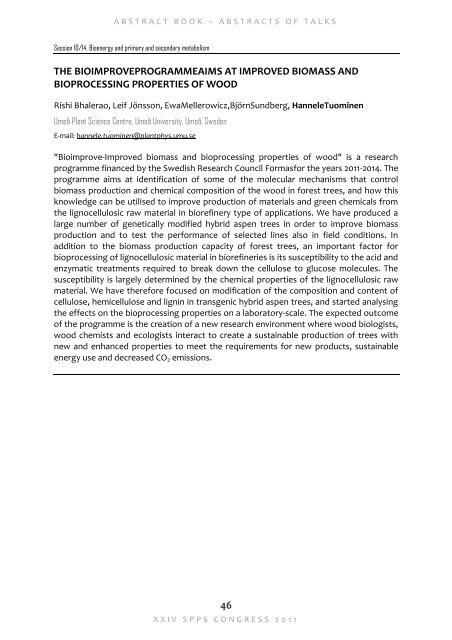1. Front Cover.cdr - CORE
1. Front Cover.cdr - CORE
1. Front Cover.cdr - CORE
You also want an ePaper? Increase the reach of your titles
YUMPU automatically turns print PDFs into web optimized ePapers that Google loves.
A B S T R A C T B O O K – A B S T R A C T S O F T A L K S<br />
Session 10/14. Bioenergy and primary and secondary metabolism<br />
THE BIOIMPROVEPROGRAMMEAIMS AT IMPROVED BIOMASS AND<br />
BIOPROCESSING PROPERTIES OF WOOD<br />
Rishi Bhalerao, Leif Jönsson, EwaMellerowicz,BjörnSundberg, HanneleTuominen<br />
Umeå Plant Science Centre, Umeå University, Umeå, Sweden<br />
E-mail: hannele.tuominen@plantphys.umu.se<br />
"Bioimprove-Improved biomass and bioprocessing properties of wood" is a research<br />
programme financed by the Swedish Research Council Formasfor the years 2011-2014. The<br />
programme aims at identification of some of the molecular mechanisms that control<br />
biomass production and chemical composition of the wood in forest trees, and how this<br />
knowledge can be utilised to improve production of materials and green chemicals from<br />
the lignocellulosic raw material in biorefinery type of applications. We have produced a<br />
large number of genetically modified hybrid aspen trees in order to improve biomass<br />
production and to test the performance of selected lines also in field conditions. In<br />
addition to the biomass production capacity of forest trees, an important factor for<br />
bioprocessing of lignocellulosic material in biorefineries is its susceptibility to the acid and<br />
enzymatic treatments required to break down the cellulose to glucose molecules. The<br />
susceptibility is largely determined by the chemical properties of the lignocellulosic raw<br />
material. We have therefore focused on modification of the composition and content of<br />
cellulose, hemicellulose and lignin in transgenic hybrid aspen trees, and started analysing<br />
the effects on the bioprocessing properties on a laboratory-scale. The expected outcome<br />
of the programme is the creation of a new research environment where wood biologists,<br />
wood chemists and ecologists interact to create a sustainable production of trees with<br />
new and enhanced properties to meet the requirements for new products, sustainable<br />
energy use and decreased CO2 emissions.<br />
46<br />
X X I V S P P S C O N G R E S S 2 0 1 1


